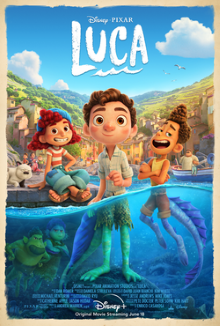This Pixar film didn’t seem to make much of a splash on its release and I even preferred to watch Turning Red from a year later before this. I came back to this after seeing some beautiful still images of the fictional town of Portorosso it is set in and realized that it’s inspired by Italian culture. Pretty as its art is, its themes and its story make it too juvenile to take seriously and its references to Italy too generic to be meaningful. It’s watchable but it feels almost boring next to Turning Red.
Luca Paguro is a member of an underwater dwelling species who live off the coast of the town of Portorosso. The landbound humans have long suspected their existence and calling them sea monsters hunt them whenever they appear. As a result, Luca’s parents have always warned him against venturing to the surface. However he has always been fascinated by human-made artefacts and one day while examining a phonograph, he meets Alberto Scorfano. Alberto is a fellow sea monster but lives by himself on a deserted island and keeps a collection of human artefacts. Luca discovers that their distinctive underwater features are magically transformed into human equivalents on land and soon regularly goes to play with Alberto on his island. They are especially fascinated by a poster advertising the Vespa scooter and Luca dreams of riding one to explore the surface world. When Luca’s parents discover what he has been up to, they decide to send him to live in the deep, dark ocean with his uncle. He therefore flees with Alberto to Portorosso and disguising themselves as human children, they befriend a local girl Giulia.
It’s immediately apparent that this is a modern take on The Little Mermaid but without the romantic angle. Luca’s fascination for human society and curiosity about the wider world is both endearing and certainly a more admirable motive for wanting to venture out of the milieu he was born in. That this happens specifically in the context of an Italian fishing village in the 1950s gives it even more charm as he learns how to ride a bicycle on the cobblestoned twisty and narrow streets, how to eat Italian pasta with a fork, and playing with other kids in the picturesque town. Upholding the Vespa as a symbol of the freedom to travel and explore seems a little strange to me coming from a boy who has only known life under the sea, but I suppose it works as a symbol of Italy. The art is really the best part of the film as it’s great to see the Italian town, which may be fictional but is similar to many real ones, rendered in Pixar’s house style.
Yet to make the surface world feel attractive, the undersea world must be made to seem dreary. The film therefore tries to minimize scenes of the underwater society but that was always going to be a tough sell given the inherent wondrous nature of such a world. The magical nature of their’ ability to switch between water and land forms is never explained and there is no attempt to do any world building whatsoever. It just feels so strange and unfair to hold Portorosso up so highly at the expense of Luca’s own homeland. Why does Giulia have so little curiosity about what it’s like underwater? In general the film as a whole feels like this: well-intentioned and sweet but integrates many different elements without considering how well they fit together. I believe that director Enrico Casarosa was inspired by Hayao Miyazaki to go for a fanciful approach, with flying scenes aplenty and whimsical, dream-like imagery. But without being grounded in real details, the result is unconvincing and shallow to me.
It could well be that this might appeal more to Italians and certainly it would be great to see more films inspired by Italian culture. But my opinion is that this is a poor effort. It compares especially poorly to Turning Red which, despite its fantastical elements, feels rooted in a specific time and place and the specific problems of young women. Portorosso is a pretty place here but that’s all this film has going for it.
